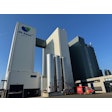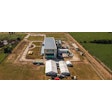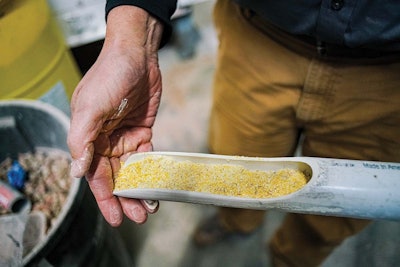
Nestled behind a grain elevator and surrounded by rolling farm hills, Farmers’ Grain & Feed’s new feed mill can be hard to spot when driving through the small town of Allenton, WI.
The mill is bustling with activity, however, offering hundreds of modern, high-quality dairy cattle feeds in bulk or bags while maintaining the atmosphere of the friendly local feed store.
Farmers’ Grain & Feed, a division of West Bend Holdings, was founded as a co-op in 1913 by the Hess family. The company stayed a co-op for the next 93 years. Then in 2006, Tim Kreilkamp, president of Farmers’ Grain & Feed, and his father made the decision to diversify and buy the co-op, turning it into a division of their company, WB Holdings, and taking it private.
The Kreilkamp family has a long history in Allenton, WI. A fourth-generation family-owned company, WB Holdings started as a trucking company in 1935 by Kreilkamp’s great grandfather. The trucking company was only a few blocks from the Farmers’ Grain & Feed’s old feed mill. Though the company now has locations across the United States, its roots are firmly planted in Wisconsin.
Separating manufacturing from logistics
Every quarter, each West Bend Holdings division meets with an advisory committee to learn what they can do better.
“They challenged us to do more and increase the amount of feed we were making,” says Kreilkamp.
The main stumbling block was storage, loadout bins specifically. When producing feed at the old mill, batches would often go directly from the mixer into a waiting truck.
“We would have a batch of feed made, but the truck needing to be loaded wouldn’t be there,” says Kreilkamp. “At that point, we would have to stop making the feed to wait for the truck. The tail was wagging the dog.”
The panel discussed ideas on how to expand at the old site, but most involved sacrificing something else at the site, like an office building.
With no good options to expand feed storage at the old site, Farmers’ Grain & Feed decided to build new. The company already owned the land around the current site of its grain elevator, and the built-in synergies of having a grain elevator next to its feed mill were a positive. At first, the company planned to build a small mill at the grain elevator and keep both the new mill and old mill in operation.
“The further into the planning we got, the two-mill idea stopped making sense,” says Kreilkamp. “We just wanted to add more and more to the new mill and eventually decided the best thing to do was put all the manufacturing in one spot at the new mill and make it as efficient as possible.”
Drive for data
Farmers’ Grain & Feed’s new mill is close in size to the footprint of the old mill, but it makes four times the feed.
The company went from making 150 tons/day of feed to 600 tons/day in the same amount of space by embracing the efficiency that modern feed manufacturing technology brings — the most important being data collection and analysis.
“We’re using Microsoft’s Power Bi to visualize the data collected from the systems throughout the mill,” explains Kreilkamp. “It helps pull the data we collect together and displays it as a graph. Once enough data has been gathered, the plan is to have dashboards that allow us to follow the data and use it to measure ourselves. It makes us smarter.”
Glenn Schellinger, mill manager, says the integration between the batching software in the new ERP software is a big change. He says they can now see what was sent to manufacture and what was manufactured and then send it back to home base to print the invoice.
“Once you work out the glitches, having the different software talk to each other is impressive,” he says.
Some of the advantages of the new feed mill’s automation and data collection will have immediate and continuous impacts, improving efficiency through the mill.
“The augers moving feed from our bins to the scales slow down as they get close to the target to avoid overfilling,” says Kreilkamp. “If the auger fills too much, it’s continuously self-correcting. It makes itself smarter, and the more you use it, the smarter it gets. There’s simply no way we could have a program like that at our old mill.”
The grain elevator
The new mill has another advantage over the old. It’s located just yards from the company’s grain elevator. Now, with just the push of a button, Farmers’ Grain & Feed can convey bulk grain into its mill. Removing the need to haul grain to the site saves the company money and increases its efficiency, but also helps it meet customer expectations.
“The big push in the dairy industry right now is consistency. Cows like consistency,” says Schellinger.
He explains that more dry corn has been going into dairy cattle diets in the last few years and having corn that can be reclaimed to a feed mill without trucking makes the mill more efficient.
“The diets are more stable,” Schellinger continues. “Corn silage and haylage already have so many nutrition variations, keeping the corn steady makes the cow’s diet better.”
Having the two facilities next to each other allows Farmers’ Grain & Feed to cross-train its staff to work where they are most needed.
Kreilkamp hopes the flexibility and efficiency the new mill offers reduces overtime hours so employees can have better work-life balances.
“There is a lot of passion here with this team,” says Kreilkamp. “They’ve all bought into what we’re doing here. We have 22 people working at this site but virtually zero turnover. We don’t have people leave unless it’s a retirement or sickness. A customer can tell when someone is there to punch a clock versus someone who wants to be there. We’re proud that our people want to keep working here.”
Community passion
If the Farmers’ Grain & Feed open house for the mill is any indication, the local community is as passionate about the new mill as the employees. Despite it being on a wet, near-freezing November day, more than 1,200 people came to tour the mill during the event.
“I did not hear one negative word about the mill during the open house,” says Kreilkamp. “Everyone seemed happy, especially the producers from the area. The producers are excited and passionate about what they do, and they like seeing that we’re just as excited and willing to take the initiative to invest in their industry.”
Passion for the industry and the community has led Farmers’ Grain & Feed’s down a long path — from trying to engineer ways to improve a turnkey mill, to planning to run two smaller mills, and finally to making a significant investment in one hi-tech mill.
That same passion, and a new feed mill, will keep Farmers’ Grain & Feed serving Allentown, WI, and its surrounding dairies for years to come. ■
.jpg?auto=format%2Ccompress&crop=faces&fit=crop&h=48&q=70&w=48)

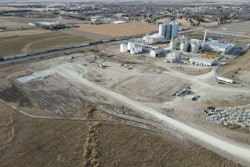
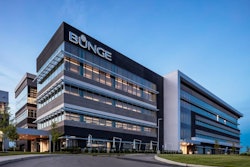
.png?auto=format%2Ccompress&fit=crop&h=167&q=70&w=250)






